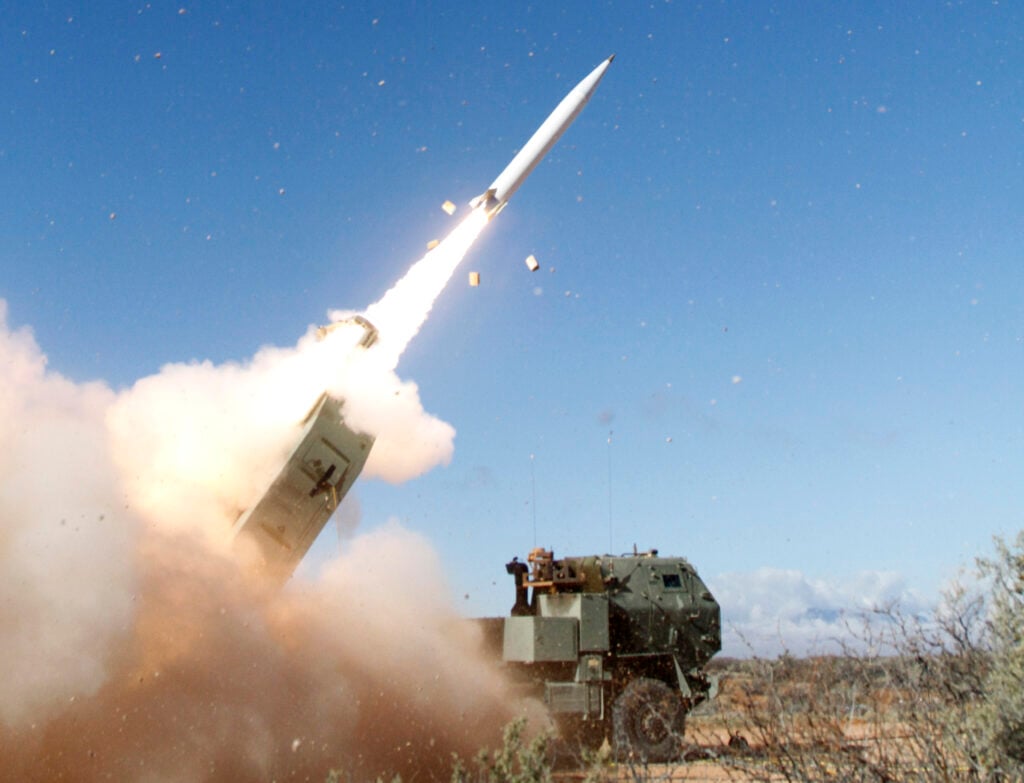
Lockheed’s prototype Precision Strike Missile (PrSM) fires from an Army HIMARS launcher truck in its first flight test, December 2019.
WASHINGTON: “It was a pretty exciting 91 seconds or so,” the Army’s artillery modernization director said this morning after the third successful flight test of Lockheed Martin’s new Precision Strike Missile.
To strike the target just 85 kilometers (53 miles) away – knife-fight distance for PrSM, designed to fly over 310 miles (500 km) – “the missile almost has to start tipping over as soon as it comes out of the launcher,” Brig. Gen. John Rafferty told reporters. “It has to burn off a lot of energy” very fast to hit a target so close.

Gen. John “Mike” Murray
“This was the shortest distance for the flight test [program so far],” added Rafferty’s boss, Army Futures Command chief Gen. John Murray. “It’s actually the most challenging flight test because of the range.”
Also challenging: COVID-19. Test personnel used masks and social distancing, with only the most essential personnel on site. Even the program office watched the event via webcast. Despite these awkward but necessary measures, “we’re right on schedule,” Murray said: The PrSM program is on track to deliver the first 30 missiles to combat units in 2023 as planned, a key element of the Army’s overhaul of its long-neglected artillery.
So what are the next steps for the program?
2021: Long-Range Testing
Lockheed Martin is already under contract for long-lead components for the four missiles scheduled to fly next year, Precision Fires VP Gaylia Campbell told me after the Army call. “They awarded that last December [and] we are definitely out ordering material” for the components that take the longest to manufacture, she said, although she’s not at liberty to discuss which ones.
Lockheed and the Army are right now working out “hopefully the final details” of the full contract for the next phase of testing, formally known as ETMRR (Extended Technology Maturation & Risk Reduction), she said.
That phase includes three flight tests involving four missiles, since one test will look at firing two in close succession from the same launcher, which requires very careful timing to prevent the rocket blast from one interfering with the next. This feature is especially important because PrSM is half the size of the ATACMS missile it will replace – yet just as deadly, thanks to advances in explosives – so a tracked M270 MRLS launcher can carry two and a wheeled HIMARS can carry four.
Those tests, next year, will test the missile to its current maximum range of over 500 km (310 miles), exceeding the limit imposed on tactical weapons by the now-defunct INF Treaty. How much farther, the Army and Lockheed won’t say. But it’s far enough that the massive White Sands Missile Range in New Mexico, which hosted today’s test, may not be able to accommodate it.
“The Army’s looking at several different options as to how we actually fly that far,” Campbell told me. White Sands doesn’t usually handle test flights at such distances, but the service is studying options to try something non-traditional there or to move to another test range altogether.

Army Multiple Launch Rocket System
2023: First Fielding
2023 will see what the Army calls an “Urgent Material Release” of the first 30 PrSM missiles to an operational artillery unit. Because Lockheed carefully designed it to fit in the existing M270 MLRS and HIMARS launchers, the Army won’t have to build a new fleet of vehicles to fire it, just train the crews on a few new procedures – mainly to load a different-sized missile – and add the weapon’s characteristics to the artillery branch’s existing AFATDS software.
Now, the version of PrSM currently in testing and set to enter service in 2023 can only home in on static coordinates, much like the existing ATACMS. That still makes it highly effective against enemy airfields, Gen. Murray said, as well as targets that set up in one location and don’t relocate frequently, like the larger radars and long-range missile batteries that form the backbone of a Russian or Chinese-style anti-aircraft systems. The plan is for Army artillery to blast a path through enemy air defenses for Air Force, Navy, and Marine Corps airstrikes, as well as its own Future Vertical Lift aircraft now being developed to replace conventional helicopters.
But the Army also wants to be able to strike moving targets, like Chinese warships in the Western Pacific or Russian armored columns in Eastern Europe. That upgrade will take another two years – slow by the standards of Silicon Valley but lightning quick for a government program.

Then-Col. John Rafferty teaches field artillery operations in Tajikistan.
2025: Killing Moving Targets
The Army’s Aviation & Missile Center, with help from industry, is already working on a new “multi-mode seeker” to track moving targets. It should be ready for “hands-on testing outside the lab… in the next couple of months,” Rafferty said.
Lockheed has set aside space, weight, and electrical power in the current design to add the seeker when it’s ready, Campbell told me. What’s more, the entire missile is being built with what’s called an open architecture, which simplifies all future upgrades by establishing a standard interface that can – at least on paper – plug and play new components from any manufacturer, as long as they build them according to the standard.
That means the Army isn’t locked into Lockheed as the sole source for upgrades, even though the only rival bidder for the missile, Raytheon, dropped out after problems in testing.
Murray said he had “no concerns whatsoever about being down to one competitor, [and] I think there’ll be an opportunity to introduce competition back into this program as we go forward.”
That’s because the open architecture should allow multiple companies to offer upgrades, and because the Army owns the design, including the necessary intellectual property and technical data to make modifications, without having to rely on Lockheed.
That said, Lockheed feels pretty confident of its place on the program, Campbell made clear, given the company’s 40 years of building similar weapons. Lockheed is already expanding its Camden, Ark. facility to handle increased demand for existing products like ATACMS and the smaller, shorter-ranged GMLRS. A new “Long-Range Fires Building” now under construction will be complete by year’s end, she told me, and while its initial focus is ATACMS, it’ll handle future PrSM production as well.
Lockheed is also confident it can offer cutting-edge technology for the next big upgrade after the seeker: extended range.

Approximate ranges in miles from Chinese territory to select US and allied targets. SOURCE: Google Maps
TBD: Extended Range
At over 500 km, the initial 2023 model of PrSM will already significantly outrange the existing ATACMS. The Army wants it to go even further – but not at the price of making it bigger. That means the extended-range version of PrSM will need a more powerful but equally compact rocket motor.
“We think 650 to 700 km [400 to 435 miles] is entirely possible,” Rafferty said, “but we’ve got a long way to go with the rocket technology in this form factor: We want to stay inside the current launch pod container, we want to stay inside the HIMARS and MLRS fleet.”
Lockheed has already presented the Army options for how to reach greater ranges without changing the missile’s size, Campbell told me. “We have a lot of modeling and simulation data that we can draw from, and we would be very confident we can provide that capability to the Army in the same form factor,” she said. “It’s not going to require some new invention.”
Neither Lockheed nor the Army would commit to any kind of timeline to develop an 400-mile-plus PrSM. But greater range would be keenly appreciated by commanders, especially in the vastness of the Western Pacific.
In a ‘world first,’ DARPA project demonstrates AI dogfighting in real jet
“The potential for machine learning in aviation, whether military or civil, is enormous,” said Air Force Col. James Valpiani. “And these fundamental questions of how do we do it, how do we do it safely, how do we train them, are the questions that we are trying to get after.”


























